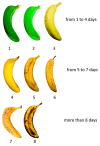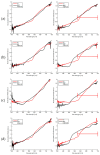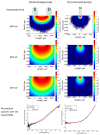Evaluation of Diffuse Reflectance Spectroscopy Vegetal Phantoms for Human Pigmented Skin Lesions
- PMID: 39517908
- PMCID: PMC11548278
- DOI: 10.3390/s24217010
Evaluation of Diffuse Reflectance Spectroscopy Vegetal Phantoms for Human Pigmented Skin Lesions
Abstract
Pigmented skin lesions have increased considerably worldwide in the last years, with melanoma being responsible for 75% of deaths and low survival rates. The development and refining of more efficient non-invasive optical techniques such as diffuse reflectance spectroscopy (DRS) is crucial for the diagnosis of melanoma skin cancer. The development of novel diagnostic approaches requires a sufficient number of test samples. Hence, the similarities between banana brown spots (BBSs) and human skin pigmented lesions (HSPLs) could be exploited by employing the former as an optical phantom for validating these techniques. This work analyses the potential similarity of BBSs to HSPLs of volunteers with different skin phototypes by means of several characteristics, such as symmetry, color RGB tonality, and principal component analysis (PCA) of spectra. The findings demonstrate a notable resemblance between the attributes concerning spectrum, area, and color of HSPLs and BBSs at specific ripening stages. Furthermore, the spectral similarity is increased when a fiber-optic probe with a shorter distance (240 µm) between the source fiber and the detector fiber is utilized, in comparison to a probe with a greater distance (2500 µm) for this parameter. A Monte Carlo simulation of sampling volume was used to clarify spectral similarities.
Keywords: biological tissue phantoms; diffuse reflectance spectroscopy; pigmented skin lesions; principal component analysis; skin diagnosis.
Conflict of interest statement
The authors declare no conflicts of interest.
Figures





















Similar articles
-
Preliminary results on the use of a noninvasive instrument for the evaluation of the depth of pigmented skin lesions: numerical simulations and experimental measurements.Lasers Med Sci. 2010 May;25(3):403-10. doi: 10.1007/s10103-009-0724-x. Epub 2009 Sep 8. Lasers Med Sci. 2010. PMID: 19763669
-
Role of In Vivo Reflectance Confocal Microscopy in the Analysis of Melanocytic Lesions.Acta Dermatovenerol Croat. 2018 Apr;26(1):64-67. Acta Dermatovenerol Croat. 2018. PMID: 29782304 Review.
-
Optical clearing of melanoma in vivo: characterization by diffuse reflectance spectroscopy and optical coherence tomography.J Biomed Opt. 2016 Aug;21(8):081210. doi: 10.1117/1.JBO.21.8.081210. J Biomed Opt. 2016. PMID: 27300502
-
Toward the discrimination of early melanoma from common and dysplastic nevus using fiber optic diffuse reflectance spectroscopy.J Biomed Opt. 2005 Nov-Dec;10(6):064020. doi: 10.1117/1.2135799. J Biomed Opt. 2005. PMID: 16409085
-
Skin Cancer Detection Technology.Dermatol Clin. 2019 Oct;37(4):527-536. doi: 10.1016/j.det.2019.05.010. Epub 2019 Jul 10. Dermatol Clin. 2019. PMID: 31466592 Review.
References
-
- Ferlay J., Ervik M., Lam F., Laversanne M., Colombet M., Mery L., Piñeros M., Znaor A., Soerjomataram I., Bray F. Global Cancer Observatory: Cancer Today. Lyon, France: International Agency for Research on Cancer. 2024. [(accessed on 19 June 2024)]. Available online: https://gco.iarc.who.int/today.
-
- Vidrio R.M.G., Lozano N.C. Confronting melanoma in the 21st century. Med. Cutánea Ibero-Lat.-Am. 2007;35:3–13.
-
- Goldstein B.G., Goldstein A.O. Diagnosis and management of malignant melanoma. Am. Fam. Physician. 2001;63:1359–1368, 1374. - PubMed
-
- Lino-Silva L.S., Domínguez Rodríguez J.A., Aguilar Romero J.M., Martínez Said H., Salcedo Hernández R.A., García Pérez L., Herrera Gómez A., Cuellar-Hubbe M. Melanoma in Mexico: Clinicopathologic Features in a Population with Predominance of Acral Lentiginous Subtype. Ann. Surg. Oncol. 2016;23:4189–4194. doi: 10.1245/s10434-016-5394-x. - DOI - PubMed
-
- Jurado Santa Cruz F., Medina Bojórquez A., Gutiérrez Vidrio R.M., Ruiz Rosillo J.M. Epidemiological study of skin cancer prevalence in three cities of Mexico. Rev. Medica Inst. Mex. Seguro Soc. 2011;49:253–258. - PubMed
MeSH terms
Grants and funding
LinkOut - more resources
Full Text Sources

